english version: intro - contents - library - resources - feedback - digital - classes 1 2 3 4 5 6 7 8 9 10 11 - circuit-fantasia.com
bulgarian version: intro - contents - library - resources - feedback - digital - classes 1 2 3 4 5 6 7 8 9 10 11 - groupes 61 63 64
The 13th Int. Conference ELECTRONICS'2004 - Sozopol, Bulgaria, September 22-24, 2004
WEB-BASED BUILDING COURSE ON ANALOG ELECTRONICS
(one teacher's story)
Cyril Svetoslavov Mechkov
Department of Computer Systems, Technical University of Sofia,
mail: 1756 Sofia, P.O.Box. 5, Bulgaria, phone: +359 888 546 707,
e-mail: cyril@circuit-fantasia.com, site: http://www.circuit-fantasia.com
Keywords: e-teaching, e-learning, analog electronics, electronic circuits, building approach.
The web-based building course on analog electronics (english and bulgarian versions) described in this paper is designed as a supplementary means to the classical analog electronics courses. It is implemented during the spring term of 2004 in the exercises with the students from the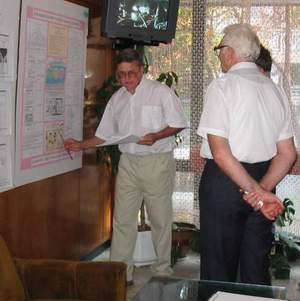 Faculty of Computer Systems and Faculty of Communication Technology.
Faculty of Computer Systems and Faculty of Communication Technology.
The course proposed consists of seven parts: Contents, Class descriptions, Library, Student lists, Resources, Feedback.
The goals of the course are posed in the Introduction. Here, in order to illustrate the building approach to the students, a few interactive flash movies are included.
Contents reveals the strucure of the course in a form of hierarchical classification. In this exposition, the electronic circuits are not presented as ready-made circuit solutions. Instead, they are built systematically according to the bulding approach - every new circuit based on the previous ones.
The implementation of all the 11 class exercises is described in the Class descriptions by means of problems, provoking questions, small projects, feedback forms etc.
The circuit building blocks "invented" are gathered into a library with the purpose of their future use in the next classes. The collection is hierarchically organized according to the contents.
Student lists contain a personal information about the students: names, e-mails, sites, ICQ, phones etc. They also include an additional information about the classes (chronicle) including fun stories, photos etc.
A special part on the site - Resources - is allocated to related web resources: similar basic electronics cources, tutorials, web sites.
All the comments coming from colleagues, students, web readers etc. are placed in the Feedback page. Also, a lot of e-mail buttons with subjects prepared, forms, counters etc. are intended in order to give a feedback.
1. INTRODUCTION.
In the spring of 2004 I was teaching two electronics courses together at the Technical University of Sofia: Analog electronics (class exercises with the students from the Faculty of Computer Systems) and Digital electronics (lab exercises with the students from the Faculty of Communication Technology). It was a great pleasure to me to teach analog and digital electronics together as I was able to expose to the students the universal relationship between the phenomena in electronic circuits.
At the time, I have already accumulated a lot of educational resources (tutorials, interactive movies, pictures, circuit phenomena and paradoxes etc.) about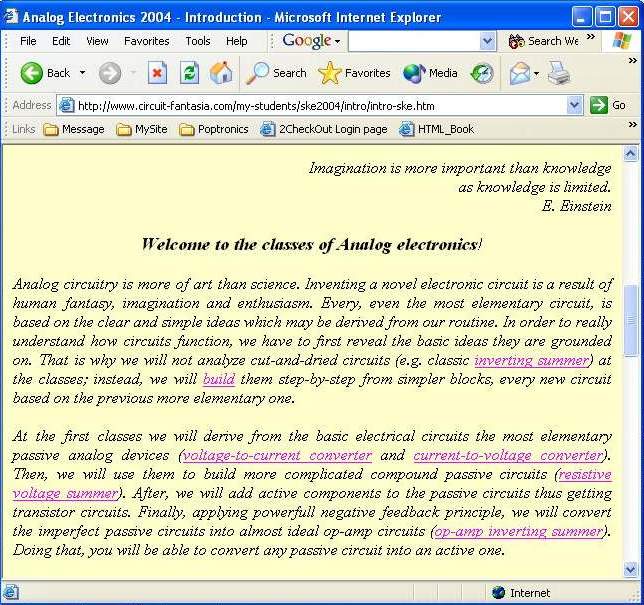 electronic circuits located on my site of circuit-fantasia.com. So, an idea flashed through my mind - to rearrange all the materials in a form most suitable for my students. Thus I decided to begin creating a supplementary course on the web, in order to support both the classes on Analog electronics and the labs on Digital electronics. Well, here is the story of this my new initiative on the web.
electronic circuits located on my site of circuit-fantasia.com. So, an idea flashed through my mind - to rearrange all the materials in a form most suitable for my students. Thus I decided to begin creating a supplementary course on the web, in order to support both the classes on Analog electronics and the labs on Digital electronics. Well, here is the story of this my new initiative on the web.
2. STRUCTURE. In the beginning, I had to build the hierarchical structure of the course. So, I decided to organize the materials into seven parts as follows.
2.1. Introduction. First, in order to motivate and to inspire the students, I wrote an emotional introduction. Here I posed the goals of the course introducing the building approach [1] to the students. As an example, I included a few flash movies illustrating how to build some of the most popular electronic circuits:
voltage-to-current converter,
current-to-voltage converter,
resistive voltage summer,
op-amp inverting summer etc.
In the intro I outlined the site structure including a set of internal and external links to the various resources. I decided to code the links with a different color (for example, I specified a fuchsia color to the links pointing interactive multimedia flash movies such as op-amp circuit builder); for this purpose, I placed a color key in the intro. Also, as I used a lot of unusual interactive means (potential bars and diagrams, current loops, superimposed I-V curves etc.) in order to visualize and even sound the invisible electrical attributes of the circuits, I placed a small flash demo with legends about colors and sounds used on the front page.
A. PASSIVE ANALOG CIRCUITS
Passive Analog Converters Containing Resistive Elements
Class 1: Elementary Passive Converters with Current Output
Class 2: Elementary Passive Converters with Voltage Output
Class 3: Compound Passive Converters with Voltage Output
Passive analog converters containing reactive elements
Class 4: Passive Integrators and Differentiators
B. ELECTRONIC ANALOG CIRCUITS WITHOUT FEEDBACK
Class 5: Diode Circuits
Class 6: Transistor Circuits without Feedback
C. ANALOG CIRCUITS WITH IMPERFECT NEGATIVE FEEDBACK
Class 7: Transistor Circuits with Feedback
D. ANALOG CIRCUITS WITH PERFECT NEGATIVE FEEDBACK
Class 8: Op-amp Amplifiers with Negative Feedback
Class 9: Op-amp Converters with Parallel Negative Feedback
E. ANALOG CIRCUITS WITH POSITIVE FEEDBACK
Class 10: Op-amp Circuits with Positive Feedback
F. MIXED (ANALOG & DIGITAL) CIRCUITS
Class 11: Components and Sub-systems for Analog-Digital Signal Processing |
2.2. Contents. Then I wrote a detailed contents of the subject where I structured the course in a form of 11 logically connected classes. In this exposition the electronic circuits were not presented as ready-made circuit solutions. Instead, according to the bulding approach, they were building systematically, every one new circuit based on the previous ones.
Following the circuit evolution in analog electronics, I took a decision to divide the contents of the subject into six main parts >>>.
2.3. Class descriptions: 1 • 2 • 3 • 4 • 5 • 6 • 7 • 8 • 9 • 10 • 11.
Besides the contents of the class exercises, every week I released also current class descriptions. In these 11 units, using a lot of provoking questions, problems, small projects, forms etc., I tried to reveal in a funny way the phenomena behind circuits as follows.
At the beginning, I and my students were deriving from the basic electrical circuits the most elementary passive resistive analog devices with current (unit 1) and voltage (unit 2) output. Then, following the building idea, we used them to build more complicated compound resistive circuits with voltage input/output (unit 3) and also some classic time dependant circuits containing reactive elements (unit 4).
After, we added electronic components to the passive circuits thus getting basic diode (unit 5) and transistor (unit 6) circuits [2]. Next, we applied the powerful negative feedback principle to the transistor circuits [3] thus getting classic transistor amplifying circuits (unit 7). Similarly, applying a feedback to the op-amp amplifying circuits [4], we got basic op-amp amplifiers with negative feedback (unit 8); then (unit 9) we converted the imperfect passive circuits from part A into almost ideal op-amp circuits [5, 6].
A special part (unit 10) was separated for the basic circuits with positive feedback. Finally, the course finished with mixed (analog and digital) circuits (unit 11).
Below is an example derived from class exercise 9 where we have discussed how to make an almost ideal current source. By the way, what is the general idea behind this circuit :)? What does the op-amp really do in the circuit? If you do not guess, roll over the diagrams in order to get an answer.
How do we make an almost ideal current source? |
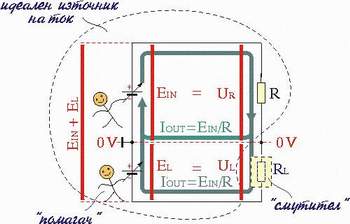
Sorry, I have not yet translated the text. By the way, what do you think is written on the diagrams :)?
|
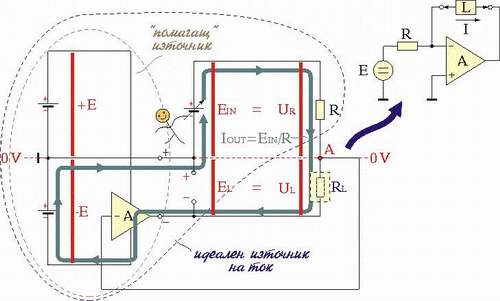
|
2.4. Library. On every class I and my students were "inventing" a couple of circuit building blocks. With the purpose of their future use in the next classes, we 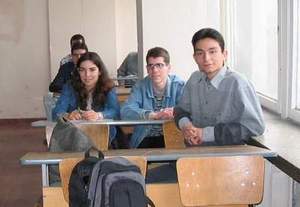 were gathering the new circuits "invented" into a library of circuit building blocks. Thus the collection was continuously growing and growing through the semester.
were gathering the new circuits "invented" into a library of circuit building blocks. Thus the collection was continuously growing and growing through the semester.
2.5. Student lists. In this part of the site I was keeping a personal information about the students in form of groupe lists containing the student names, e-mails, sites, ICQ, phones etc. (see for example the BG-versions of the groupes 61, 63 and 64). Besides this staff-work, a was placing an additional information about the classes (chronicle) including fun stories, photos etc.
In these groupe pages I was noting the student progress through the semester. Also, I was used the e-mail adresses to communicate with the students (e.g. to examine the students in the end of the semester).
2.6. Resources. I divided a special part on the site where I placed links pointing to related web resources: Physics 123 electronics course taught by Tom Hayes at Harvard University; Lessons In Electric Circuits maintained by Tony Kuphaldt (Bellingham Technical College, Washington); the more practical basic electronics course of Basic Car Audio Electronics maintained by Perry Babin etc. In order to stimulate my students, I got in touch with these authors. They wrote kind words about the building electronics course which I placed in the feedback page (see below).
2.7. Feedback. For the first time I was implementing such a web initiative with students; so, I needed a feedback in order to correct and improve the site. With this purpose I located a lot of e-mail buttons with subjects prepared, forms, counters etc. I even started a feedback part where I intended to place all the comments coming from colleagues, students, web readers etc.
As almost all the subject of analog electronics is based on the feedback principle, I divided the feedback page into 4 parts: positive, negative, mixed and even ... missing :). See these pages to know what the people thought about the course. If you want, you might also give me a feedback!
3. CONCLUSION. During the spring term of 2004 I managed to put the building approach into practice using all the materials I have created during the last years on the web. My students rapturously accepted the web-based building electronics course described. Now, I am inspired to improve the analog electronics course and to implement a new web experiment next year again.
4. REFERENCES.
4.1. Papers.
[1] Mechkov C., Building electronics tutorial , Proceedings of The 12-th Int. Conference ELECTRONICS'2003, 2003.
[2] Mechkov C., Looking for an idea: Common-emitter amplifier in three steps, Engineering Review, January 1999.
[3] Mechkov C., "Invention" of the basic transistor gain stages trough negative feedback methode, Proceedings of The Seventh Int. Conference ELECTRONICS'97, 1998.
[4] Mechkov C., Heuristic presentation of the negative feedback principle, Proceedings of The Sixth Int. Conference ELECTRONICS'97, 1997.
[5] Mechkov C., Heuristic methods for converting passive analogue devices into negative feedback active circuits , Proceedings of The Sixth Int. Conference ELECTRONICS'97, 1997.
[6] Mechkov C., Parallel negative feedback circuit builder , Proceedings of The 12 th Int. Conference ELECTRONICS'2003, 2003.
[7] Mechkov C., Heuristic course on analog electronics, Proceedings of The 32-th Conference of the Faculty of Communication Technology, Technical University of Sofia, 1997.
4.2. Links. In order to navigate easily through the site, you may use the list of links below:
Build to Understand Circuits is a building electronics tutorial that I began creating with great enthusiasm last year (I have temporarily stopped this part, but I will resume it in the future) :
Introduction reveals the philosophy of this novel approach in electronics education,
Unit 1: Voltage Causes Current introduces the first most elementary building blocks.
Circuit builders (I made these movies last year):
pnfb-builder (demo) "invents" over 40 popular circuits based on the parallel negative feedback principle, for example
build_integrator (demo) reveals the basic idea behind an op-amp inverting integrator and shows how to build this popular circuit,
strange-things builds over a dozen op-amp circuits with a disturbance into the feedback loop,
v-to-v-act-sum-build maps the classic summer diagram to the "building" one.
Old pages presenting some circuit building blocks, which I made about 2 years ago:
v-to-i "invents" the elementary passive voltage-to-current converter,
i-to-v creates the opposite current-to-voltage converter,
v-to-v-sum builds the compound passive resistive summer,
v-to-v-active-sum transmutes the passive summer into an active one.
circuits is hierarchically organized old circuit classification, which I made about 2 years ago:
passive-circuits shows the most elementary electrical circuit building blocks,
circuits-with-nfb is based on the powerful "active copy" principle (e.g. negative feedback):
evolving-followers presents circuits in the following order -- non-disturbed -> disturbed -> deliberately disturbed -> varying disturbed,
interacting-systems shows that like people in society negative feedback systems may interact i.e.
aiding-systems -- aiding each other or
opposing-systems -- opposing each other.
Old pages presenting general information about my site:
introduction reveals my own teaching philosophy.
examples-of-inventing tells how I reveal a powerful circuit idea.
my-great-penetrations is a collection of circuit concepts I have realized.
my-creative-evolution presents my very informal biography.
Circuit Questions & Answers is started in September 2003:
great-answers contains general questions about circuits (I have currently stopped it but will resume soon),
all-answers contains "ordinary" questions about circuits (currently stopped),
Question of the Week shows the current (weekly) question.
list_of_questions contains the Questions of the Week (weekly updated).
Paradoxes of Electronics is another part of the site started in September 2003 where I show the great paradoxes and absurds in the electronic circuits::
Paradox of the Week shows the current paradox,
list_of_paradoxes contains the Paradoxes of the Week (weekly updated).
Other weekly updated columns: contradictions, conflicts, principles, building schemes, circuit_building blocks.
Building Analog Electronics Course is a new part of the site started in March 2004 dedicated to my students:
introduction poses the goals of the building electronics course.
contents reveals the structure of the course in a form of hierarchical classification.
class descriptions ( 1 , 2 , 3 , 4 , 5 , 6 , 7 , 8, 9, 10, 11) describe the implementation of all the 11 class exercises.
library contans the circuit building blocks "invented" through the course.
feedback includes all the comments coming from colleagues, students, web readers etc.
resources contains useful web resources.
english version: intro - contents - library - resources - feedback - digital - classes 1 2 3 4 5 6 7 8 9 10 11 - circuit-fantasia.com
bulgarian version: intro - contents - library - resources - feedback - digital - classes 1 2 3 4 5 6 7 8 9 10 11 - groupes 61 63 64
 Faculty of Computer Systems and Faculty of Communication Technology.
Faculty of Computer Systems and Faculty of Communication Technology.